深度优先遍历简称DFS(Depth First Search),广度优先遍历简称BFS(Breadth First Search),它们是遍历图当中所有顶点的两种方式。
我们来到一个游乐场,游乐场里有11个景点。我们从景点0开始,要玩遍游乐场的所有景点,可以有什么样的游玩次序呢?
深度优先遍历
二叉树的前序、中序、后序遍历,本质上也可以认为是深度优先遍历。
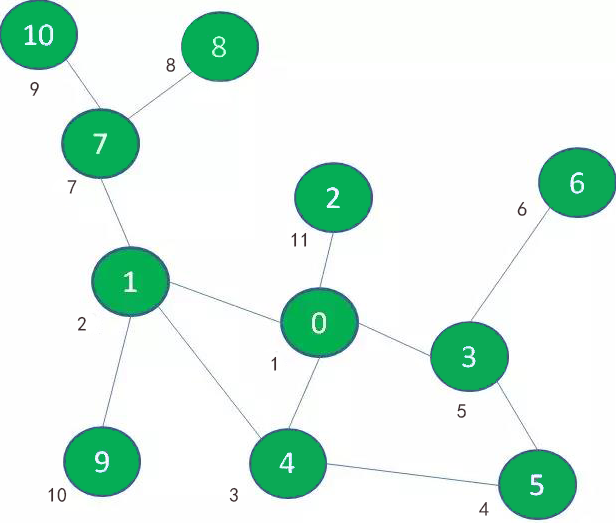
第一种是一头扎到底的玩法。我们选择一条支路,尽可能不断地深入,如果遇到死路就往回退,回退过程中如果遇到没探索过的支路,就进入该支路继续深入。
在图中,我们首先选择景点1的这条路,继续深入到景点4、景点5、景点3、景点6,终于发现走不动了(景点旁边的数字代表探索次序):
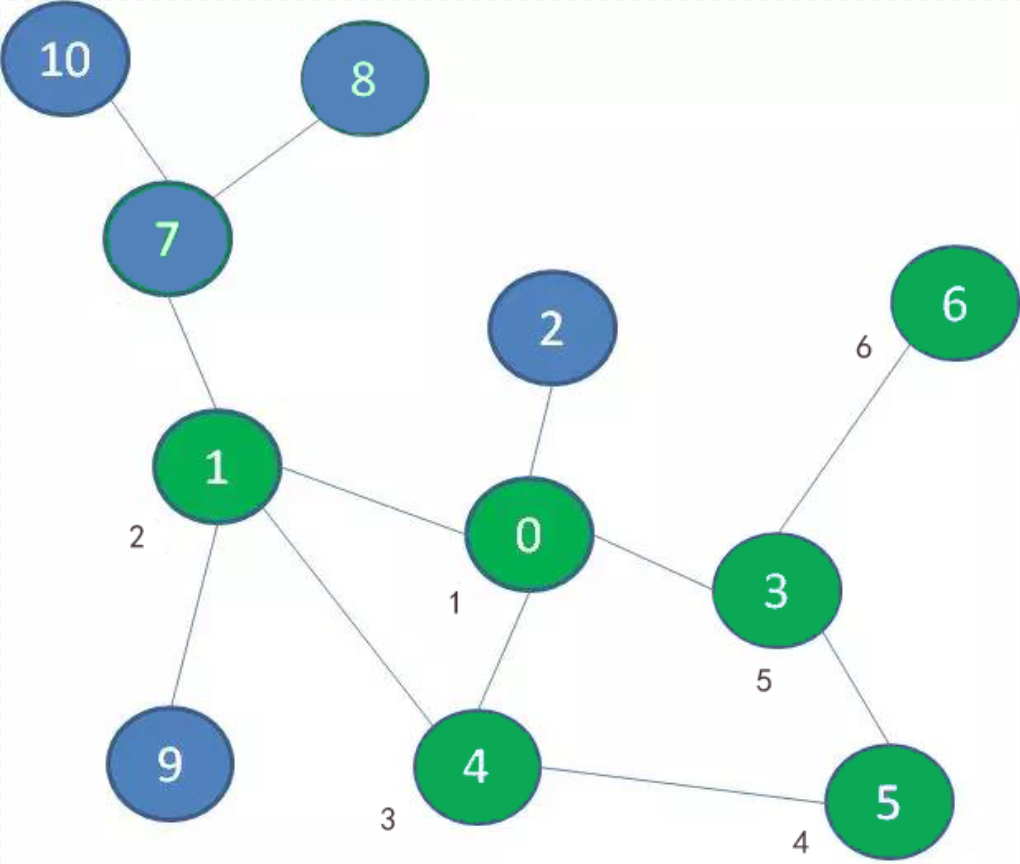
于是,我们退回到景点1,然后探索景点7,景点8,又走到了死胡同。于是,退回到景点7,探索景点10:

按照这个思路,我们再退回到景点1,探索景点9,最后再退回到景点0,后续依次探索景点2,终于玩遍了整个游乐场:

广度优先遍历
二叉树的层序遍历,本质上也可以认为是深度优先遍历。
在图中,我们首先探索景点0的相邻景点1、2、3、4
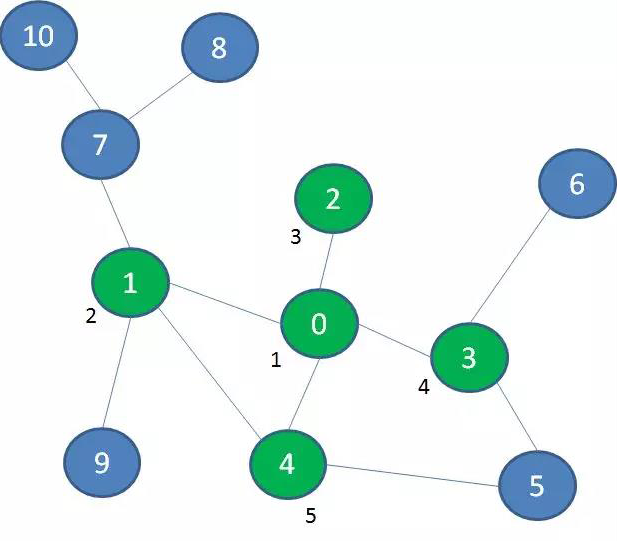
接着,我们探索与景点0相隔一层的景点7、9、5、6:
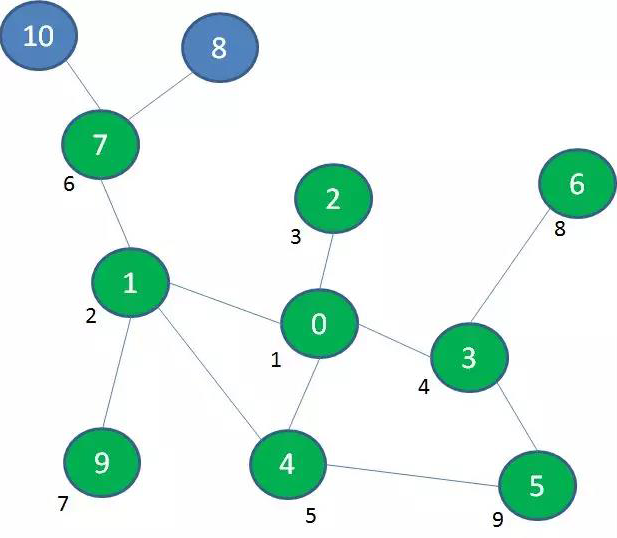
最后,我们探索与景点0相隔两层的景点8、10:
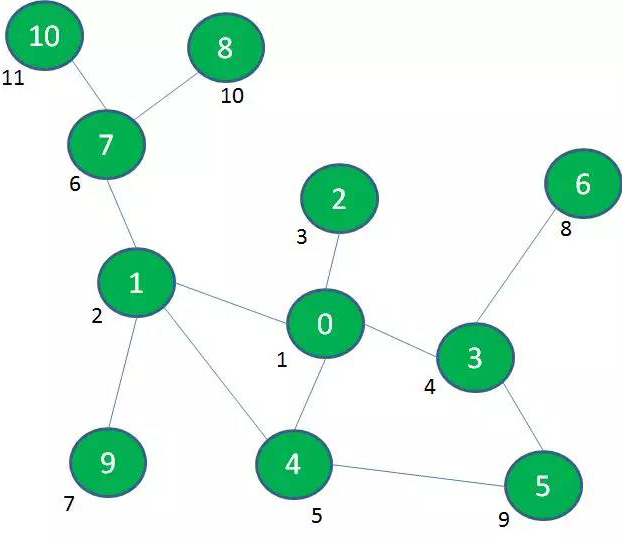
<?php /** * 图的深度优先遍历、广度优先遍历 * 图的存储结构--邻接矩阵 */ class Graph { // 存储节点信息 public $vertices; // 存储边信息 public $arcs; // 图的节点数 public $vexnum; // 记录节点是否已被遍历 public $visited = []; // 初始化 public function __construct($vertices) { $this->vertices = $vertices; $this->vexnum = count($this->vertices); for ($i = 0; $i < $this->vexnum; $i++) { for ($j = 0; $j < $this->vexnum; $j++) { $this->arcs[$i][$j] = 0; } } } // 两个顶点间添加边(无向图) public function addEdge($a, $b) { if ($a == $b) { // 边的头尾不能为同一节点 return; } $this->arcs[$a][$b] = 1; $this->arcs[$b][$a] = 1; } // 从第i个节点开始深度优先遍历 public function traverse($i) { // 标记第i个节点已遍历 $this->visited[$i] = 1; // 打印当前遍历的节点 echo $this->vertices[$i] . PHP_EOL; // 遍历邻接矩阵中第i个节点的直接联通关系 for ($j = 0; $j < $this->vexnum ; $j++) { // 目标节点与当前节点直接联通,并且该节点还没有被访问,递归 if ($this->arcs[$i][$j] == 1 && $this->visited[$j] == 0) { $this->traverse($j); } } } //深度优先遍历 public function dfs() { // 初始化节点遍历标记 $this->init(); // 从没有被遍历的节点开始深度遍历 for ($i = 0; $i < $this->vexnum; $i++) { if ($this->visited[$i] == 0) { // 若是连通图,只会执行一次 $this->traverse($i); } } } // 初始化节点遍历标记 public function init(){ for ($i = 0; $i < $this->vexnum; $i++) { $this->visited[$i] = 0; } } //广度优先遍历 public function bfs() { // 初始化节点遍历标记 $this->init(); $queue = []; for ($i = 0; $i < $this->vexnum; $i++) { // 对每一个顶点做循环 if (!$this->visited[$i]) { // 若是未访问过就处理 $this->visited[$i] = 1; // 设置当前顶点访问过 echo $this->vertices[$i] . PHP_EOL; // 打印顶点 $queue[] = $i; // 将此顶点入队列 while (!empty($queue)) { // 若当前队列不为空 $curr = array_shift($queue); // 将队对元素出队 for ($j = 0; $j < $this->vexnum; $j++) { if ($this->arcs[$curr][$j] == 1 && $this->visited[$j] == 0) { $this->visited[$j] = 1; // 将找到的此顶点标记为已访问 echo $this->vertices[$j] . PHP_EOL; // 打印顶点 $queue[] = $j; // 将找到的此顶点入队列 } } } } } } } /* 0 1 2 3 4 5 6 7 8 9 10 0 0 1 1 1 1 0 0 0 0 0 0 1 1 0 0 0 1 0 0 1 0 1 0 2 1 0 0 0 0 0 0 0 0 0 0 3 1 0 0 0 0 1 1 0 0 0 0 4 1 1 0 0 0 1 0 0 0 0 0 5 0 0 0 1 1 0 0 0 0 0 0 6 0 0 0 1 0 0 0 0 0 0 0 7 0 1 0 0 0 0 0 0 1 0 1 8 0 0 0 0 0 0 0 1 0 0 0 9 0 1 0 0 0 0 0 0 0 0 0 10 0 0 0 0 0 0 0 1 0 0 0 so 0 1,2,3,4 1 0,4,7,9 2 0 3 0,5,6 4 0,1,5 5 3,4 6 3 7 1,8,10 8 7 9 1 10 7 */ // 测试 $vertices = ['景点0', '景点1', '景点2', '景点3', '景点4', '景点5', '景点6', '景点7', '景点8', '景点9', '景点10']; $graph = new Graph($vertices); $graph->addEdge(0, 1); $graph->addEdge(0, 2); $graph->addEdge(0, 3); $graph->addEdge(0, 4); $graph->addEdge(1, 4); $graph->addEdge(1, 7); $graph->addEdge(1, 9); $graph->addEdge(3, 5); $graph->addEdge(3, 6); $graph->addEdge(4, 5); $graph->addEdge(7, 8); $graph->addEdge(7, 10); // 递归 echo "dfs:"; $graph->dfs(); echo "<br />"; echo "bfs:"; $graph->bfs();